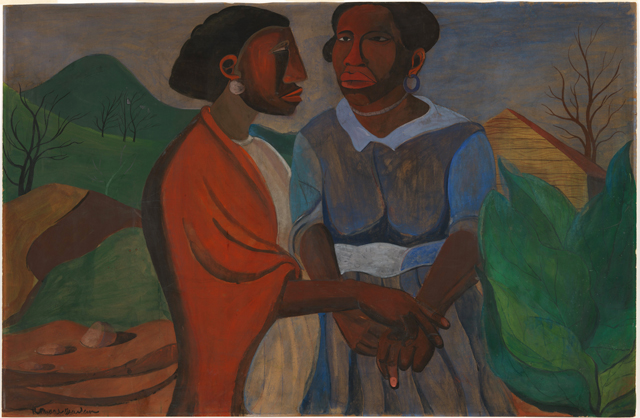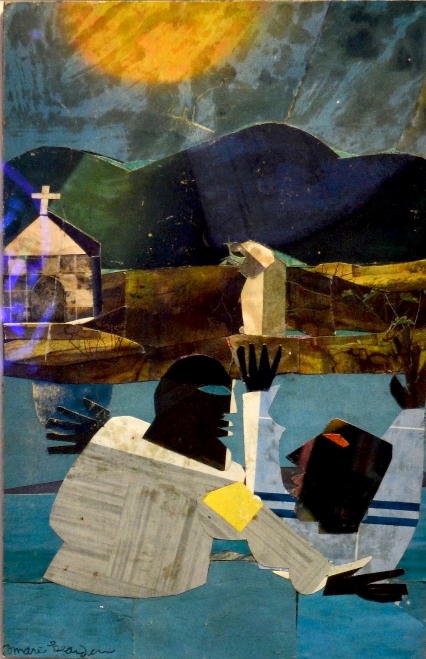Advent - The Visitation by Romare Bearden
Romare Bearden: The Visitation

Biblical, Personal, Universal
by James Romaine
Romare Bearden’s The Visitation is an understated mid-20th-century painting in the collection of Museum of Modern Art, in New York City. It depicts two African American women standing side-by-side in a bleak landscape. This terrain is populated by some barren trees, a few rocks, a wooden structure, and a leafy plant.
Art-historical precedent would suggest that the woman in red is the Virgin Mary. She greets her cousin with a gesture of blessing. The women’s hands converge over the body of Elizabeth. Perhaps this in response to her declaration, “As soon as the sound of your greeting reached my ears, the baby in my womb leaped for joy.” However, the closer we look at Bearden’s painting, the less it seems to depict Mary’s visit to her cousin Elizabeth as recounted in the Gospel of Luke. Bearden has reinterpreted this biblical narrative in a modern context.

Painted in 1941 The Visitation is one of Bearden’s earliest mature works. This formative work could be read in the context of Bearden’s attempt to launch his artistic project. Today Bearden is renowned for his work in collage such as Baptism. The Visitation, however, portends the direction of Bearden’s oeuvre in at least three ways: 1) it employs a mix of personal memories and universal narratives; 2) its visual language asserts the African foundation of European Modernism; and 3) it evidences Bearden’s own sense of artistic identity and purpose as an African American artist.
Like many of Bearden’s works The Visitation celebrates the perseverance of African Americans in face of Jim Crow laws in the southern US that enforced racial segregation. Bearden had been born in Mecklenburg County, North Carolina in 1911. Even though he lived most of his adult life in the Harlem community of New York City, Bearden used his own memories and stories that he collected from others to root his art in the cultural landscape of the rural American South. While no specific place seems to be indicated in this painting, the hills rising into mountains recall the landscape of his childhood. By imagining contemporary life as a biblical narrative Bearden heroized the daily struggles of ordinary people.
Bearden’s Mary and Elizabeth are African American women dressed in modern clothing. He employed the heavy forms of their bodies to visualize a strength of inner spirit. The slim trees in the painting contrast with the women’s commanding presence. Bearden’s representation of Mary and Elizabeth may have been inspired by the strong matriarchs in his own family. In their personal independence and social activism Bearden’s grandmother and mother were role models of personal resilience in face of adversity. While the women in The Visitation are not portraits after specific persons, they represent the presence of powerful female figures supporting each other. By envisioning a biblical narrative in the circumstances of his own life experiences, Bearden introduced a method of integrating the modern and the universal that he would employ for the rest of his career.
While the presence of the two women dominates Bearden’s composition, the forms of their bodies and the features of their faces have been both simplified and exaggerated. The sharp profile of the woman at our left resembles an African mask. Like many American artists in the first half of the 20th century Bearden looked to European artists, such as Pablo Picasso and Henri Matisse, as models. Bearden transformed the visual language of European Modernism by applying it to African American subjects. Bearden knew that the development of Modernist art depended heavily on the precedent of African sculpture. Since Modernism was indebted to African art, Bearden felt that he could make a claim on this visual method. He believed that he was repossessing an aesthetic method that was already his own.
Bearden also drew directly from works of African art, which he saw for example in a 1935 exhibition at the Museum of Modern Art in New York City. He admired how African sculptors abstracted the human body and face. These artists skillfully exaggerated certain features, deliberately departing from naturalistically depicting their subject for expressive purposes.
This reinvention of European Modernism, by asserting its African sources, reflected Bearden’s artistic identity and the sense of purpose. Bearden’s family had moved from North Carolina to New York City when he was a child, so that he grew up in the midst of the Harlem Renaissance. Because of his mother’s social activism, he had personal contact with many literary, musical, and artistic figures of the Harlem Renaissance. For Bearden the Harlem Renaissance opened opportunities and challenges. One of the questions he wrestled with throughout his career was “What type of art should African American artists create?” Should they focus on distinctly “African American” motifs and methods or should they attempt to transcend race and just be “an artist?” In The Visitation Bearden skillfully navigated between these positions. The painting visually articulates the struggles of contemporary African Americans. By evoking the biblical narrative in his title, he elevated the particular moment into the realm of universal human experience.

The Visitation is a key work from the first chapter in Bearden’s oeuvre. He would return to religious motifs throughout his career. Some of these works, such as Baptism, celebrated the spiritual life of the African American community. In other works, such as The Passion of Christ series, Bearden depicted biblical scenes to visualize contemporary social issues. These biblical subjects gave both a spiritual orientation and historical weight to his faith in the triumph over injustice and suffering. At the same time Bearden revitalized the history of Christianity and the visual arts by giving it modern purpose.
*******
Romare Bearden: The Visitation, 1941, gouache, ink, and pencil on colored paper, 77,5 x 118 cm. Museum of Modern Art, New York, NY, USA.
Romare Bearden: Baptism, 1964, collage, 25 x 16 cm. Romare Bearden Foundation, New York, NY, USA.
Romare Bearden: Golgotha, 1945, watercolor, ink, and graphite on paper, 50,5 x 64,8 cm. The Metropolitan Museum of Art, New York, NY, USA.
Romare Bearden (1911-1988) was an American artist, author, and songwriter. He worked with many types of media including cartoons, oils, and collages. Born in Charlotte, North Carolina, Bearden grew up in New York City and Pittsburgh, Pennsylvania. He began his artistic career creating scenes of the American South. Later, he worked to express the humanity he felt was lacking in the world after his experience in the US Army during World War II on the European front. He returned to Paris in 1950 and studied art history and philosophy at the Sorbonne. Bearden's early work focused on unity and cooperation within the African American community. After a period during the 1950s when he painted more abstractly, this theme reemerged in his collage works of the 1960s. The New York Times described Bearden as "the nation's foremost collagist" in his 1988 obituary. Bearden became a founding member of the Harlem-based art group known as The Spiral, formed to discuss the responsibility of the African American artist in the civil rights movement. Bearden was the author or coauthor of several books. He also was a songwriter, known as co-writer of the jazz classic "Sea Breeze", which was recorded by Billy Eckstine, a former high school classmate at Peabody High School, and Dizzy Gillespie. He had long supported young, emerging artists, and he and his wife, Nanette Rohan, established the Bearden Foundation to continue this work, as well as to support young scholars. In 1987, Bearden was awarded the National Medal of Arts. (Wikipedia)
James Romaine is Professor of art history at Lander University in Greenwood, SC, USA. He is the co-founder of the Association of Scholars of Christianity in the History of Art (ASCHA). His publications include Beholding Christ and Christianity in African American Art (Penn State University Press, 2018) and a chapter in Kunst D.V. – (Neo)calvinistische perspectieven op esthetica, kunstgeschiedenis en kunsttheologie. His videos can be seen on YouTube at SeeingArtHistory. https://youtu.be/xbcjY8hOCoY
ArtWay Visual Meditation 19 July 2020


